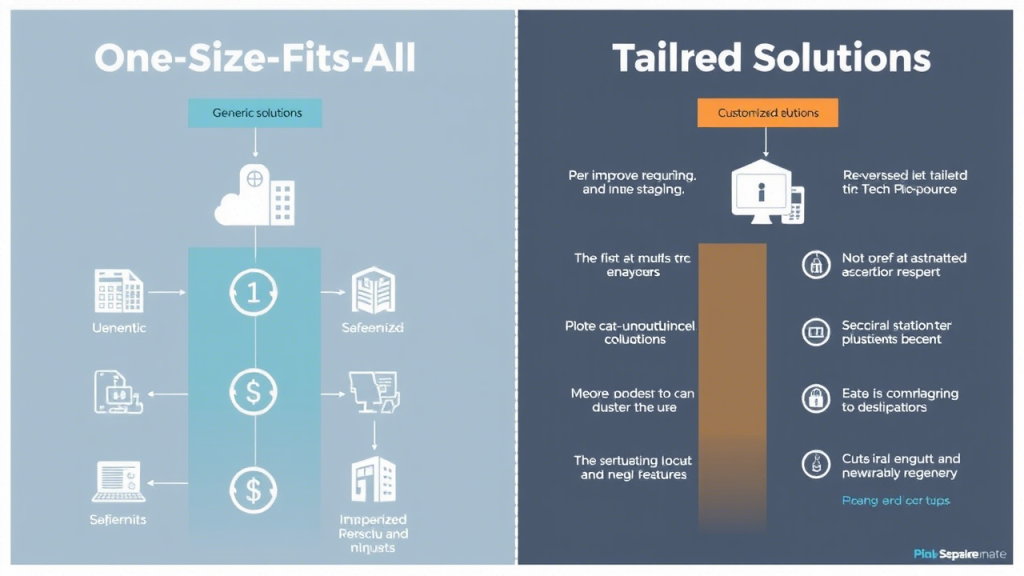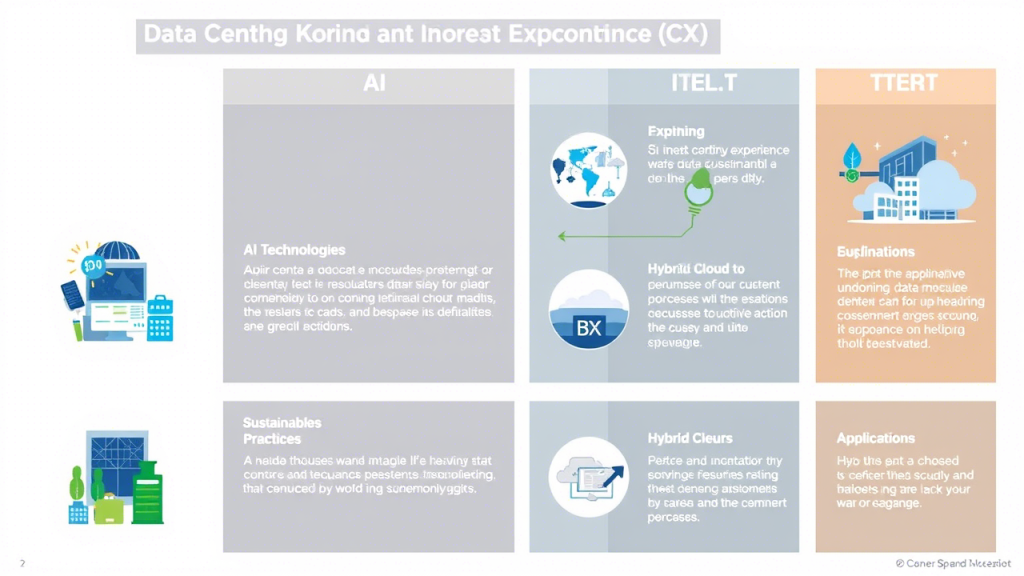Organizations face challenges aligning operations with evolving client expectations. Traditional, one-size-fits-all approaches yield suboptimal results. Companies risk falling behind rapidly adapting competitors without focusing on Customer Experience in Data Centers.
Imagine a data center with frequent downtime, security vulnerabilities, and systems that fail to scale. This is more than a technical issue for IT managers, data center operators, and CX professionals—it threatens customer trust and efficiency. Businesses lack customized CX for data centers and tailored solutions, so they struggle to meet rising demands.
By understanding why one size doesn’t fit all in data center CX and adopting Data center customer experience strategies focused on Personalization and innovative methods, organizations can significantly enhance Improving data center customer experience.
This approach plays a pivotal role in transforming operations and building lasting relationships. Unlock your data center’s true competitive potential.
Understanding Customer Experience in Data Centers
The landscape of data centers has shifted dramatically. Modern customers demand more than reliable storage and processing power—they seek a secure, flexible, and personalized experience. Let’s break down what Customer Experience in Data Centers really entails.
What Constitutes a Stellar Data Center Experience?
- Reliability: Customers expect systems that operate seamlessly, with minimal downtime.
- Security: With increasing cyber threats, robust security measures are non-negotiable.
- Scalability: As business needs evolve, so should the data center’s capacity.
- Personalization: Every client is unique. Offering tailored solutions can set your service apart.
The Role of Technology and Human Expertise
Modern data centers blend advanced technologies with human oversight. IT managers and data center operators must collaborate with CX professionals to optimize every aspect of the customer journey.
Interested in elevating your customer experience? Explore Reboot Monkey’s services to learn how we can help you achieve your goals.
Why One Size Doesn’t Fit All in Data Center CX?
No two customers are alike. This is especially true in data centers where diverse business requirements demand Customized CX for data centers.
The Pitfalls of a One-Size-Fits-All Approach
- Inflexibility: Generic solutions often fail to address specific operational challenges.
- Lack of Personalization: Without Personalization, customers feel undervalued.
- Missed Opportunities: Standardized approaches can hinder innovation and growth.
The Value of Tailored Solutions
Adopting tailored solutions allows data centers to address each customer’s specific needs. This approach not only enhances satisfaction but also drives efficiency and innovation. The message is clear: Why one size doesn’t fit all in data center CX is not just a catchphrase—it’s a critical business strategy.
The Competitive Edge of Customized CX
In today’s market, offering Customized CX for data centers can be a game-changer. By focusing on personalized experiences, companies can build stronger, more resilient relationships with their clients.
Additional Insights
- Customer-Centric Culture: Shifting the organizational mindset to focus on the customer.
- Feedback Loops: Regular customer feedback is essential to refine and improve experiences.
- Proactive Strategies: Anticipating customer needs rather than just reacting to issues.

Key Factors Driving Data Center Customer xperience Strategies
Developing effective Data center customer experience strategies requires a multifaceted approach. Here, we’ll explore the key factors that drive these strategies and how each element contributes to an exceptional customer journey.
Reliability and Uptime as a CX Priority
Why Reliability Matters?
Reliability is the backbone of any data center operation. Consistent uptime is not just a technical requirement—it’s a promise to your customers. For many organizations, even a few minutes of downtime can lead to significant revenue loss and a damaged reputation.
Strategies for Enhancing Uptime
- Redundant Systems: Implement backup systems to ensure continuous operation.
- Proactive Maintenance: Regular system checks and updates can preempt failures.
- Real-Time Monitoring: Advanced monitoring tools help identify and resolve issues swiftly.
Security and Compliance as Customer Expectations
The Imperative of Robust Security
Security is at the forefront of Improving the data center customer experience. Customers demand that their data be protected with the highest levels of security, and any breach can lead to a hard-to-rebuild loss of trust.
Best Practices in Security
- Encryption: Use advanced encryption methods to secure data transmissions.
- Compliance: Adhere to industry standards and regulations to ensure trust and accountability.
- Access Controls: Limit access to sensitive data only to authorized personnel.
Scalability and Flexibility: The Need for Personalized Approaches
Scaling to Meet Evolving Needs
Scalability is a critical factor in Data center customer experience strategies. As businesses grow, their data center needs evolve. A rigid, inflexible system can quickly become a bottleneck.
Personalized Scalability Solutions
- Modular Design: Build systems that can expand as needed.
- Cloud Integration: Leverage cloud services to offer scalable solutions.
- Custom Configurations: Offer tailored solutions that align with specific business requirements.
Personalization: The Future of Data Center Customer Experience
Personalization is emerging as the future of Customer Experience in Data Centers. By delivering Customized CX for data centers, companies can build deeper relationships and drive long-term success.
Understanding the Role of Personalization in CX
The Shift Towards Personalization
Personalization is no longer a luxury—it’s a necessity. Modern customers expect experiences that cater specifically to their needs. This means moving away from generic solutions and embracing strategies that focus on individual requirements.
Benefits of a Personalized Approach
- Enhanced Satisfaction: Customers feel valued when their unique needs are met.
- Increased Loyalty: A personalized experience fosters long-term relationships.
- Operational Efficiency: Customized systems can lead to more efficient resource utilization.
How Data Centers Can Offer Tailored Solutions?
Implementing Tailored Solutions
Offering tailored solutions requires a deep understanding of customer needs and the flexibility to adapt quickly. Here are some practical steps:
- Customer Segmentation: Identify different customer groups and tailor services accordingly.
- Feedback Integration: Regularly gather and analyze customer feedback to inform service improvements.
- Dynamic Resource Allocation: Use advanced algorithms to allocate resources based on real-time demand.
The Role of Technology
Cutting-edge technologies such as AI and machine learning can analyze vast amounts of data to predict customer needs and optimize operations. This not only enhances Improving data center customer experience but also paves the way for proactive management.
Emerging Trends in Data Center Customer Experience
As data centers evolve, new technologies and shifting market demands continue shaping how we approach Customer Experience in Data Centers. Today’s market calls for Customized CX for data centers that respond to each client’s unique needs.
Here are some of the emerging trends driving innovation in the industry:
Integration of Advanced Technologies
Integrating artificial intelligence (AI) and machine learning revolutionizes Data center customer experience strategies.
These technologies empower IT managers and data center operators to predict potential issues before they escalate, ensuring smoother operations and Improving data center customer experience.
AI-driven analytics enable real-time monitoring and resource optimization, helping organizations deliver tailored solutions that address individual customer needs.
Focus on Sustainability and Energy Efficiency
Sustainability is no longer optional—it’s a core element of modern data center operations. Data centers can enhance their Customer Experience in Data Centers by investing in energy-efficient systems and sustainable practices.
This trend supports personalization by aligning services with the values of eco-conscious customers and reducing operational costs and environmental impact. It’s an essential strategy for organizations seeking to demonstrate corporate social responsibility while maintaining high performance standards.
Adoption of Hybrid Cloud and Edge Computing
The move toward hybrid cloud environments and edge computing is redefining service delivery. These innovations allow data centers to offer more flexible and scalable solutions, which are vital for Improving data center customer experience.
By combining the strengths of on-premises infrastructure with cloud-based resources, data centers can provide Customized CX for data centers that dynamically adjust to customer needs.
This approach clearly illustrates Why one size doesn’t fit all in data center CX, ensuring that every client receives a bespoke service package tailored to their operational challenges.

The Pivotal Role of IT Managers and Data Center Operators in CX
The success of any data center strategy relies heavily on the expertise and commitment of IT managers, data center operators, and CX professionals. Their combined efforts drive Customer Experience in Data Centers to new heights.
Bridging the Gap Between Technology and Customer Needs
The Multifaceted Role of IT Managers
IT managers oversee the technological backbone of data centers. Their role is pivotal in ensuring that systems run efficiently while adapting to customer needs. They must balance operational requirements with strategic initiatives aimed at Improving the data center customer experience.
Data Center Operators: The Frontline of Service Delivery
Data center operators work tirelessly to maintain optimal performance. Their responsibilities include monitoring systems, ensuring security, and implementing tailored solutions that meet customers’ dynamic needs. Their insights are invaluable in refining Data center customer experience strategies.
Building a Collaborative Culture
Cross-Functional Teams
Encouraging collaboration between IT managers, data center operators, and CX professionals is essential. When teams work together, they can implement comprehensive strategies that address every facet of the customer journey.
Continuous Learning and Adaptation
The digital landscape is constantly evolving. To stay ahead, professionals must commit to continuous learning and innovation. Regular training, performance reviews, and the adoption of new technologies are critical in maintaining a competitive edge.
Measuring and Improving Data Center Customer Experience
Organizations must measure and refine their Customer Experience in Data Centers to ensure continuous success. This involves tracking performance, identifying areas for improvement, and implementing proactive strategies.
Key Metrics for Evaluating CX Performance:
Essential Performance Indicators
- Uptime and Reliability: Monitor system uptime as a direct indicator of service quality.
- Customer Satisfaction Scores: Regular surveys and feedback loops provide insights into customer sentiment.
- Response Times: Measure the efficiency of customer support and issue resolution.
- Security Incidents: Track and address any breaches or vulnerabilities.
Benchmarking and Analysis
Regular metrics analysis allows organizations to benchmark their performance against industry standards. This data-driven approach is essential for Improving data center customer experience over time.
Strategies for Continuous CX Improvement:
Proactive Monitoring and Feedback
Implementing real-time monitoring systems ensures that any issues are detected and resolved swiftly. In addition, establishing regular feedback mechanisms allows for continuous refinement of Data center customer experience strategies.
Training and Development
Investing in training IT managers, data center operators, and CX professionals is crucial. Upskilling teams can lead to better service delivery and successfully implement Customized CX for data centers.
Why Machine Learning Models Demand High Performance Computing (HPC)? | Reboot Monkey
Leveraging Advanced Analytics
Advanced analytics and machine learning can identify trends and predict potential issues before they escalate. This proactive approach improves performance and reinforces technology’s pivotal role in delivering exceptional customer experiences.
Overcoming Common Challenges in Enhancing CX:
Addressing Security Concerns
Security remains a top priority. Investing in robust encryption, compliance measures, and regular audits is essential. Overcoming security challenges directly impacts Improving data center customer experience by building trust with customers.
Managing Scalability Issues
As demand grows, scalability can become a challenge. Implementing modular designs and dynamic resource allocation helps mitigate these issues. Offering tailored solutions ensures that scalability does not compromise service quality.
Enhancing Communication
Clear communication between technical teams and customers is vital. Regular updates and transparent reporting can alleviate concerns and foster a collaborative relationship focused on continuous improvement.
Don’t let operational challenges hold you back. Contact Reboot Monkey to explore innovative strategies for enhancing your data center customer experience.
Future Outlook: The Evolution of Tailored Data Center CX Strategies
Looking ahead, the future of Customer Experience in Data Centers hinges on evolving strategies that prioritize tailored solutions and continuous innovation.
As customer expectations rise and technologies advance, data centers must remain agile and responsive to stay competitive.
Embracing Customization for Scalability:
The future of data centers lies in the ability to deliver Customized CX for data centers that can grow alongside businesses. Scalable, modular systems enable IT managers and data center operators to adjust rapidly to changing demands, reinforcing Data center customer experience strategies.
By adopting tailored solutions, organizations can better manage fluctuations in workload and customer requirements, showcasing Why one size doesn’t fit all in data center CX.
Fostering Innovation Through Collaboration:
Collaboration among IT managers, data center operators, and CX professionals will play a pivotal role in the future of data center management. By working together, these teams can develop comprehensive strategies that integrate customer feedback and the latest technological advancements.
This cross-functional synergy is key to Improving data center customer experience, ensuring that every aspect of service delivery is continuously optimized. Innovation fueled by collaboration leads to a more robust, proactive approach to Personalization in service offerings.
Preparing for a Proactive, Data-Driven Future:
Future data centers will increasingly rely on data-driven insights to stay ahead of challenges. Advanced analytics and real-time monitoring will become the norm, empowering organizations to anticipate customer needs and address them proactively.
This shift will further enhance Customer Experience in Data Centers by enabling continuous improvement and fostering a culture of innovation. As data centers transition to a more proactive model, Data center customer experience strategies will be refined to deliver bespoke, efficient services that consistently exceed customer expectations.
FAQs
1. What is Customer Experience in Data Centers?
Answer:
It encompasses all the interactions and processes that ensure a data center meets and exceeds customer expectations. This includes reliability, security, scalability, and personalized service.
2. Why is one size doesn’t fit all in data center CX?
Answer:
Every organization has unique operational needs and customer expectations. Generic solutions often fall short, whereas Customized CX for data centers offers tailored strategies that address specific challenges and drive better outcomes.
3. How can data centers implement tailored solutions?
Answer:
Leveraging advanced analytics, customer segmentation, and flexible infrastructure designs, these approaches help deliver personalization and scalability that align with individual business requirements.
4. What role do IT managers and data center operators play in enhancing CX?
Answer:
They are critical in ensuring that technology and operational processes work harmoniously to deliver superior service. Their expertise is central to implementing effective Data center customer experience strategies and driving continuous improvement.
5. How can companies measure Improving data center customer experience?
Answer:
Key metrics include uptime, customer satisfaction scores, response times, and security performance. Regular analysis and benchmarking are essential for continuous refinement.
Final Thoughts:
In the competitive realm of data centers, focusing on Customer Experience in Data Centers isn’t just an operational necessity—it’s a strategic imperative. Organizations can foster innovation, improve service delivery, and build lasting customer relationships by moving away from a one-size-fits-all approach and embracing Customized CX for data centers.
To summarize:
- Personalization is the future.
- Tailored solutions drive superior outcomes.
- Collaborative efforts from IT managers, data center operators, and CX professionals are key.
Every step taken towards Improving data center customer experience enhances operational efficiency and sets the stage for future success in an ever-evolving technological landscape.
Transform your data center strategy today. Contact Reboot Monkey for a personalized consultation and discover how our expert solutions can help you stay ahead in a competitive market.



